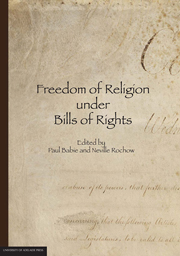Book contents
- Frontmatter
- Contents
- Acknowledgments
- List of Contributors
- Foreword by The Hon Sir Anthony Mason AC KBE: Human Rights and Courts
- INTRODUCTION
- SETTING THE SCENE
- CONTEMPORARY FREEDOM OF RELIGION ISSUES
- COMPARATIVE EXPERIENCE WITH FREEDOM OF RELIGION
- 9 Political Culture and Freedom of Conscience: A Case Study of Austria
- 10 The Sky is Falling if Judges Decide Religious Controversies! – Or is it? The German Experience of Religious Freedom Under a Bill of Rights
- 11 Religious Freedom in a Secular Society: The Case of the Islamic Headscarf in France
- 12 Religious Freedom in the UK after the Human Rights Act 1998
- 13 Judicial Interpretation, Neutrality and the US Bill of Rights
- 14 Protecting Religious Freedom: Two Counterintuitive Dialectics in US Free Exercise Jurisprudence
- 15 Walking the Tightrope: The Struggle of Canadian Courts to Define Freedom of Religion under the Canadian Charter of Rights and Freedoms
- 16 Quo Vadis The Free Exercise of Religion? The Diminishment of Student Religious Expression in US Public Schools
- 17 Freedom from Discrimination on the Basis of Religion
- 18 Ruminations from the Shaky Isles on Religious Freedom in the Bill of Rights Era
- 19 Indigenous Peoples and Bills of Rights
- TABLE OF LEGISLATION AND INTERNATIONAL INSTRUMENTS
- INDEX
18 - Ruminations from the Shaky Isles on Religious Freedom in the Bill of Rights Era
from COMPARATIVE EXPERIENCE WITH FREEDOM OF RELIGION
Published online by Cambridge University Press: 05 June 2013
- Frontmatter
- Contents
- Acknowledgments
- List of Contributors
- Foreword by The Hon Sir Anthony Mason AC KBE: Human Rights and Courts
- INTRODUCTION
- SETTING THE SCENE
- CONTEMPORARY FREEDOM OF RELIGION ISSUES
- COMPARATIVE EXPERIENCE WITH FREEDOM OF RELIGION
- 9 Political Culture and Freedom of Conscience: A Case Study of Austria
- 10 The Sky is Falling if Judges Decide Religious Controversies! – Or is it? The German Experience of Religious Freedom Under a Bill of Rights
- 11 Religious Freedom in a Secular Society: The Case of the Islamic Headscarf in France
- 12 Religious Freedom in the UK after the Human Rights Act 1998
- 13 Judicial Interpretation, Neutrality and the US Bill of Rights
- 14 Protecting Religious Freedom: Two Counterintuitive Dialectics in US Free Exercise Jurisprudence
- 15 Walking the Tightrope: The Struggle of Canadian Courts to Define Freedom of Religion under the Canadian Charter of Rights and Freedoms
- 16 Quo Vadis The Free Exercise of Religion? The Diminishment of Student Religious Expression in US Public Schools
- 17 Freedom from Discrimination on the Basis of Religion
- 18 Ruminations from the Shaky Isles on Religious Freedom in the Bill of Rights Era
- 19 Indigenous Peoples and Bills of Rights
- TABLE OF LEGISLATION AND INTERNATIONAL INSTRUMENTS
- INDEX
Summary
In modern New Zealand, public interest, debate, or for that matter, consternation over matters religious is rare: religion, God, and ‘all that church stuff’ is not a pressing concern in the lives of most of its 4.4 million citizens. In one sense the widespread cultural disinterest in organized religion that typifies much of New Zealand history may be viewed as a positive thing. It can hardly be a cause for regret that it has, by and large, not witnessed the large-scale and bitter religious turmoil that has beset many nations.
New Zealand's largest religious affiliation is Christian, and within Christianity, the largest denominations are Anglicans, Roman Catholics and Presbyterians. Unspecified numbers of Pentecostals and Evangelicals are a rapidly growing sector within Christianity as well. The actual level of churchgoing is significantly less than the official census figures, with the latest International Social Survey Programme report (in 2009) recording that some 20 per cent indicated that they attended church service at least once a month. Notably, the ‘no religion’ sector has grown significantly in each six-yearly census period since the 1970s, and the latest census, in 2006, recorded that some 34 per cent of New Zealanders identified themselves in this way.
Against this all too brief thumbnail sketch we turn now to the legal landscape. The New Zealand Bill of Rights Act 1990 (‘NZBORA’) recently celebrated its twentieth anniversary. This chapter seeks to draw some lessons from the last two decades. Specifically, it considers how one significant right, the right of religious freedom, has fared in the early years of New Zealand's Bill of Rights era.
- Type
- Chapter
- Information
- Freedom of Religion under Bills of Rights , pp. 371 - 392Publisher: The University of Adelaide PressPrint publication year: 2012



